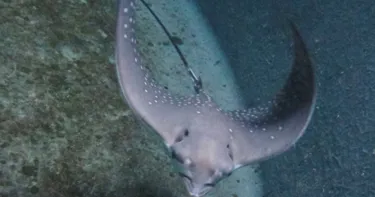Who needs a man hey?
- Thursday 30th August 2018
- Stingrays, Sea Life

Last month, in a rare scientific phenomenon, Freckle - our eleven year old female Eagle Ray gave birth to a baby Eagle Ray despite not having contact with a male for over nine years.
Freckle demonstrated a cloning process called parthenogenesis and as a result, we are now home to an adorable baby Eagle Ray named Ani who is four weeks old (born on 26th July, 2018).
Ani, which is short for Anakin, was named by our staff here at Sea Life Sydney after Anakin Skywalker - better known as Darth Vader, who also had no father. The team are pleased to report Ani is in in good health, swimming, eating and demonstrating the habits of a happy and healthy baby eagle ray - who loves eating muscles and pilchard fillets.
Freckle lives in a tank with six other female ocellated eagle rays, two leopard sharks, a white-spotted guitarfish (also a ray) and many colourful and varied 'bony' fish and has had no contact with a male since early 2009.
Adam Stow, Associate Professor at Macquarie University, specialising in Genetics and Marine Conservation says, “Freckle, a female Eagle Ray at Sea Life Sydney has successfully cloned herself and given birth to a young Eagle Ray via a process called parthenogenesis. Parthenogenesis is a very rare reproductive strategy where an embryo develops without fertilisation. It is a rare occurrence among vertebrates such as Eagle Rays - so this is a very special arrival for Sea Life Sydney Aquarium.”
Our ray team here at Sea Life Sydney Aquarium became confident that Freckle was pregnant following behavioural changes- her breathing became quicker and she was swimming faster, her appetite increased and she became more reluctant to engage in regular training sessions - a sign that she was protecting something.
Libby Eyre, Senior Aquarist and Ray Trainer at Sea Life Sydney Aquarium says, “We noticed something going on with Freckle in early June when her belly was noticeably larger. We initially dismissed pregnancy as there are no male eagle rays in the tank. As time went on we knew Freckle was indeed a mum-to-be.
“On 26th July, when I came in to check the Dugong Island tank where Freckle lives, she swam over the tunnel and there was no belly! I quickly found the bub and there were screams of excitement from the staff - everyone was amazed at the process of having produced a little ray with no males in the tank! We’re now proudly home to a very rare little baby Eagle Ray. This experience has helps expand our already extensive knowledge of this species which will assist us in their ongoing husbandry. As well as being a little miracle, we think Ani demonstrates that we have top care of this species and what a fantastic job the team is doing.”
Ani is not currently on display but the team will closely monitor her progress with a view to welcome the miracle baby to one of three oceanariums.
More Info on Parthenogenesis
About Parthenogenesis
The term parthenogenesis is taken from the Greek words parthenos, meaning “virgin,” and genesis, meaning “origin.”
How rare is parthenogenesis in Eagle Rays?
Parthenogenesis has been documented in a similar species, the spotted Eagle Ray (Aetobatus narinari) as well as ocellated eagle rays (Aetobatus ocellatus) in The Netherlands. However, it is uncommon. Burgers' Zoo in The Netherlands has had 5 young born to parthenogenesis, but none survived. It's important to remember that sexual reproduction is the normal mode of reproduction in these animals, and parthenogenesis means that the genetic diversity in the offspring is reduced, making them less robust to the challenges of the world.
Parthenogenesis in other species
Facultative parthenogenesis (when a sexually producing species switches to asexual reproduction) is known in snakes, lizards and even some birds. It has now been experienced in sharks and rays in human care, including sawfish, white tip reef sharks, blacktip sharks, bamboo sharks, leopard sharks, and spotted eagle rays.
About Adam Stow, Associate Professor at Macquarie University, specialising Genetics and Marine Conservation
Adam Stow is a conservation biologist who uses genetic and field based techniques to better understand animal behaviour and to assess the impacts of human activities. Much of his work is on marine vertebrates where he leads several research programs on sharks, including the iconic and critically endangered grey nurse shark. He heads the Conservation Genetics Laboratory and is the Director of the Masters of Conservation Biology program at Macquarie University.
About Libby Eyre, Senior Aquariust at Sea Life Sydney Aquarium
Libby Eyre has worked in the animal care industry for over thirty years, working mainly with marine animals. She specialises in providing training and enrichment for a variety of species. She has a degree in biology, and research interests in humpback whales. She has been at Sea Life Sydney Aquarium for ten years.